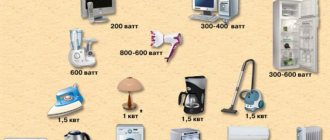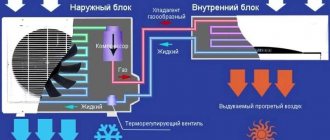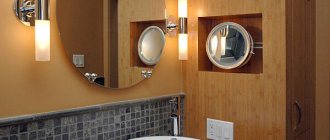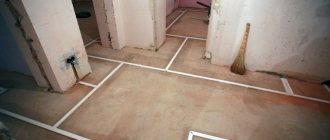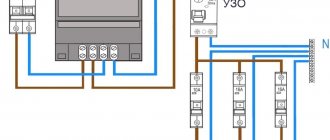Infrared heated floors are an excellent alternative to water and cable systems. They run on electricity, and spending on it is the main disadvantage of these designs. Although it is worth saying that in comparison with cable-type electric floors, the costs are significantly lower.
The level of costs associated with the operation of film floors is affected by the area of the heated room and the power of the device - find out how to select the power of different types of floor heating (water, electric). Therefore, it is important to correctly calculate the performance of an infrared floor for a specific area.
In addition, there are methods that can reduce energy costs - high-quality thermal insulation of the room and installation of the correct thermostat with a special program.
Consumption using thermostats
Installing a thermostat allows you to reduce the energy consumption of infrared floors by approximately 30 - 40%. In its absence, the surface will heat up excessively, which will reduce the comfort of the floors.
The main function of the thermostat is to monitor the heating level of the surface of the finished floors, and, if necessary, turn off and on the power supply.
Thermostats can be mechanical - designed to operate on floors no more than 12 hours a day, or automatic. On automatic devices, it is possible to install a program to control heating modes, and also use them to control the device.
The principle of operation of the thermostat is simple - when the device detects changes in temperature indicators, it turns off the power supply or resumes it when the heating degree drops below the set level.
Ways to reduce electricity consumption
To reduce the energy consumption of infrared heated floors, a number of points should be taken into account when constructing the system.
How much does a heated floor consume? Electricity consumption of a heated floor. Caleo
Power selection
To ensure a comfortable temperature level in the apartment, a film with parameters of 150 W/m2 is required. It is possible to lay a product whose power is 220 W - if the floor is the main source of heat.
It is recommended to lay infrared floors only in places where heating is required. In this case, it is necessary to strictly adhere to the installation rules. The film should cover about 70% of the total area.
For information! In country houses, on the first floors and balconies, a continuous carbon film with a special layer that protects against moisture is needed.
Insulation of the room
Thermal insulation of the room plays a big role in saving resources, that is, reducing heat loss. If the room is poorly insulated, then heat will escape through the cracks. And in order to maintain the required temperature level, the floor heating cycles will be longer, thereby increasing electricity costs.
Good thermal insulation of not only the floor, but also the walls and ceiling will help to avoid heat loss, since about 20% of the heat escapes through them. It is better to insulate the ceiling with basalt wool in two layers, and the walls with the laying of heat-insulating material and the construction of additional brickwork.
To prevent heat loss through the floors, in addition to laying thermal insulation material, an additional layer of concrete screed would be a good option. Foamed polyethylene with a reflective layer is suitable as floor insulation.
For your information! The presence of a metallized reflective layer allows you to save up to 40% of electricity, since it directs heat upward and does not allow it to escape through the ceilings in the floor.
And taking into account the fact that electricity tariffs are quite high today, this will significantly save the family budget from unnecessary expenses.
Doors and windows
Doors and windows must be installed and closed tightly to prevent warm air from escaping through them.
If these conditions are not met, then half the heat will be blown out, and the device will have to work longer, which will lead to additional costs.
Using programmable thermostats
By installing a programmable thermostat in each room, you can significantly reduce the energy consumption of film heated floors. Since its presence allows you to adjust the temperature taking into account the purpose and characteristics of the room, as well as the time of year.
Unlike a conventional device, where the thermostat turns off when the required temperature is reached and turns on when the floor is cooled, a programmable one can make adjustments according to a set time, or completely turn off the heating. Using a programmable thermostat saves up to 30% electricity.
Space zoning
Zoning the space will allow you to reduce electricity consumption, especially if you have programmable thermostats and install the alternating heating function on them. In addition, there is no need to place the film under heavy furniture - this is money down the drain.
Flooring
Since infrared film is thin, it can be installed under any floor covering.
When choosing a flooring product for a warm film floor, you need to take into account that different coatings have different degrees of thermal insulation. The level of thermal conductivity affects the power of the device that is required for a given “pie”.
Disabling the system and preventing it from working unnecessarily
An additional way to reduce energy costs is to turn off the system when the house is unoccupied. But this option is only suitable if the film floor acts as an additional heat source.
If the device is the main heating system, then turning it off is not advisable, since the room will cool down, and heating it again will take approximately the same amount of energy that you will save by turning it off.
For your information! Reducing the room heating level by just 1 degree will reduce costs by 5%.
If you follow these rules, you can significantly reduce your power costs, without affecting the comfort in your home.
Principle of operation
Electric wire used for heating consists of a nichrome core and various insulating sheaths. Such devices must be mounted in a solution. The layer of screed or tile adhesive heats up and transfers heat to the floor covering. Laminate, tile or other materials become similar to the heated surface of a convector. Only heating, unlike such an electrical appliance, occurs according to a different principle.
The convector sends streams of heated air upward. In this case, the maximum temperature is determined at the ceiling. Cold masses accumulate at the base of the room. An electric heated floor, whose electricity consumption is often less than that of a convector, creates heating in the lower part of the room. The air near the ceiling is colder. Therefore, this type of heating is more comfortable for humans.
https://youtube.com/watch?v=DblishKHMyc
Power consumption per 1 m2 depending on coverage
As mentioned above, the power of the device is influenced by the thermal conductivity of the floor covering, that is, different products require their own level of heating. If linoleum or PVC boards are laid, then it is enough to use a floor with a low power not exceeding 100 - 130 W/m2.
If the room has wooden floors, then the power of a heated film floor per 1 m2 increases in proportion to the thickness of the boards, since wood has a low degree of thermal conductivity.
It is not recommended to lay infrared floors under tiles, because the glue or screed does not come into sufficient contact with the base, which will lead to cracks on the surface.
Installation and useful tips
The surface of the base is leveled with specialized compounds. Unevenness or sudden changes can damage certain areas.
Leveling the surface of the base screed
If the base is made of boards, it is recommended to level the horizon using fiberboard or plywood. In case of strong differences, the surface is planed entirely with electric jointers, or the places of the highest differences are planed with hand tools.
Standard kit:
- Thermal film;
- Connecting wire;
- Connection terminals;
- Insulating material.
Complete set of required materials
One of the options for the external design of the thermostat
Depending on the floor covering, other components are selected.
Let's calculate the electricity consumption for one room
To calculate how much electricity an infrared heated floor consumes, you need to start from its modification and purpose - the device will be the main or additional source of heating.
The average consumption ranges from 150 to 220 W, if the film is the main heat source, then 150 - 200 W/m2, if additional - from 100 to 160. In this case, the calculated consumption is 2.5 W per hour, but the actual value is much less . This indicator can be reduced by installing a special control device. With its help, individual zones of the room are heated one by one, thereby reducing the power of the film floor by 3 times.
The energy cost indicator varies from:
- type of system - main or additional;
- floor power;
- outside air temperature;
- degree of insulation of the room;
- presence of a thermostat;
- correct installation;
- number of windows.
Therefore, it is not possible to 100% accurately calculate how much electricity a film heated floor consumes.
Example of calculating energy consumption
Power calculation for heated floors
Before you begin the calculation, you need to calculate the area of the room, determine the desired temperature, and calculate the heat loss coefficient, which is multiplied by the power of a square meter.
Let's calculate the electricity consumption using the example of a room with a total area of 60 m2. Excluding furniture, the size of the room will be 40 m2.
Heat loss from 60 m2 will be equal to 30 watts per m2, or 0.03 kW.
0.03 x 60 = 1.8 kW per hour - this is how much energy is lost per hour.
To compensate for these losses and create a comfortable atmosphere in the room, more energy will be required by 0.2 kW, that is, 2 kW. A film floor without a thermostat should have this power.
If you are planning a floor with a thermostat, then the power of 1 square meter should be 2000/40 = 50 W/m2.
When installing a programmable thermostat, a more powerful film is required - 80 W/m2. With this device, the floor will work 2 times less. Despite this, the apartment will have a comfortable temperature and low electricity consumption. Instead of 1.8, only 0.8 kW/hour.
That is, 0.8 x 24 = 19 kW, and per month the energy consumption of a film heated floor will be about 600 kW. This is the case if the infrared floor is the main source of heating.
To determine costs in monetary terms, you need to use a simple formula - multiply 600 kW by the cost of 1 kW.
For your information! Experts recommend calculating the power consumption of an infrared floor with a margin. The size of this reserve is influenced by the type of room and climatic conditions.
Heating element power
Above we examined only the standard electric “warm floor”, but today, as we know, there are several main types of this system, including:
- film floor (aka infrared);
- heating cable;
- thermomats.
Let's start with the film coating. It is used mainly where the heating system is installed under linoleum or laminate. But it is more advisable to install a cable with mats only under ceramic tiles. Each of the mentioned types has its own characteristics, parameters, and power. Now we will briefly take a look at all this.
The electricity consumption of the heating elements mentioned above is as follows:
- thermomats - if you are wondering how much electricity a warm floor of this type consumes, it is on average 120-200 watts per square meter (parameters taken from the technical characteristics of the product and Davy);
- for a film floor this figure is 150-400 watts per square meter;
- finally, for a heating cable it is only 10-600 watts (often about 30) per square meter; correctly, about five turns of heating cable are laid on each meter of area, so that the total power reaches 150 watts.
As you can see, the average power of the system ranges from 110-200 watts per square meter, thanks to which the “warm floor” can be used as a source of both main and auxiliary heating of the room. Video footage of the consumption is shown below.
Which heated floors are the most economical in energy consumption?
There are the following types of underfloor heating: water and electric, the latter in turn are divided into cable and infrared.
Water ones are connected to central heating (if permission is available) or to a specially equipped boiler. The water in the boiler is heated by electricity - in this case it is quite expensive, or the power source is gas - this is the cheapest way.
If we compare electrical systems in terms of energy consumption, it looks like this.
| Warm floor type | Energy efficiency level | Energy saving |
| Cable, in which the heating element is a cable | 68% | 58% |
| Infrared - film with carbon plates | 82% | 87% |
Based on this table, we can conclude that infrared electric floors are the most economical in terms of electricity consumption. The film heats up quickly and retains heat for a long time. In this case, heat is not wasted on heating the air, but is transferred directly to objects and people.
For your information! Any heating system intensively consumes energy only at the first stage of heating; subsequently, it spends the resource only on maintaining a given temperature level, so the consumption will be small.
It is worth saying that in addition to saving electrical energy, the infrared design ionizes the air and eliminates unpleasant odors. In addition, the film floor does not dry out the air and does not affect its humidity.
If you correctly calculate the power of the infrared floor and heat loss, and also install a thermostat, then you can easily achieve the necessary comfortable conditions in the apartment. At the same time, the system will be economical, and operating costs will not be significant.
Calculation formulas
Let's move on to the main question - how to calculate a warm floor with an electric heating element. But here everything is very simple. To determine the power of your system, simply multiply the power of one m2 by the area it will occupy.
The cable length is usually already measured in the kit for the specified power parameters and coverage area. The recommended distance between cable turns is from 5 to 20 cm. If you want to be more precise, use the following formula: h=S*100/L. As you probably guessed, h is the pitch width, S is the area, and L is the total length of the cable.
To make the calculation process even easier for yourself, you can use a special calculator for electric heated floors. Just fill in all the required fields, and the program itself will perform the necessary calculations and give you the final result.
Warm electric floor calculator
Whatever method you use, remember that it is better to spend more time at the design and calculation stage than to later spend time and money correcting mistakes. And your reward for this will be comfort and favorable weather in your home.
Laying film to save energy
It is good to lay a layer of reflective film on top. There is a special foil film with convenient metric markings that allows you to correctly lay the heating cord. You should not lay the cord without markings, and applying markings manually is quite tedious.
Laying foil film
Cunning marking devices made from ropes quickly break and get tangled. For normal installation of the cord, you need to use the factory markings.
Heating a house only with underfloor heating is unprofitable, since this results in pure electric heating.
Warm floors must be wisely combined with the installation of heating radiators.
Increased reliability
As a result of the use of infrared floors, it turned out that their service life can reach 30 years. Standard systems do not have this property. Film melting point 120℃, operational maximum 60℃.
The laminated surface of the heated floor, consisting of several layers, reliably resists mechanical stress and moisture. Ensures safe operation of the system even in the event of defects (puncture, cut).
The equipment continues to function even if one carbon element fails. Manufacturers guarantee the operation of the product for up to 10 years.
Comfort
The use of an infrared system for heating premises eliminates direct heating of the air. The human body, having received enough heat, is in a room with fresh air, optimally cool and humid.
When the system operates, no oxygen is burned, there is no noise or vibration. There is no circulation of air flows, which eliminates the presence of dust in the atmosphere. There is no need to install complex ventilation systems, since there are no combustion products or unpleasant odors.
Impact on humans
IR radiation has long been used by medicine for the prevention and treatment of diseases. The rays have special properties and help cure certain diseases. Infrared flooring has a positive effect on the human body during operation.
First of all, the rays create heat around the human body, providing him with comfortable conditions. Long-term exposure to infrared radiation slows down inflammatory processes. Has a calming effect on the nervous system. In order for a warm floor to be comfortable for residents, it must be selected and installed correctly.
How much does an electric floor consume: we calculate it ourselves
It is not difficult to determine the resource consumption for powering the heating system. This can be done in three simple steps.
Step 1: Calculate the total power
This value will show how much energy is required to operate the equipment. To calculate, you will need to calculate the heated area. It differs from the general one in that it takes into account only those areas of the room under which the heating elements are placed. On average, this is about 70%, but if it is possible to calculate accurately, it is better to do so.
Another necessary quantity is the power of the heater, depending on the type of equipment used. Can be found in the technical documentation, where it is necessarily indicated by the manufacturer. All that remains is to calculate the total power. To do this, we multiply the two quantities and get the desired value.
Example: Given a room with an area of 15 square meters. m. The heating mat is laid on 12 sq. m. Equipment power 150 W/sq. m. Determine the total power: 12*150=1800 W/sq. m.
How to save money
Installing a two-tariff meter allows you to save on heating costs with electricity. Moscow tariffs for apartments and houses equipped with stationary electric heating systems distinguish between two prices:
- 4.65 RUR from 7:00 to 23:00.
- 1.26 rubles from 23:00 to 7:00.
Then you will spend, subject to round-the-clock operation of a 9 kW electric boiler turned on at one third of the power:
9*0.3*12*4.65 + 9*0.3*12*1.26 = 150 + 40 = 190 rubles
The difference in daily consumption is 80 rubles. You will save 2400 rubles per month. Which justifies the installation of a two-tariff meter.
The second way to save when using a two-tariff meter is to use automatic control devices for electrical appliances. The idea is to place the peak consumption of an electric boiler, boiler, etc. at night, then most of the electricity will be charged at 1.26, not 4.65. While you are at work, the boiler can either turn off completely or operate in a reduced energy consumption mode, for example at 10% of power. To automate the operation of an electric boiler, you can use programmable digital thermostats or boilers with programming capabilities.
In conclusion, I would like to note that heating a house with electricity is quite an expensive method, regardless of the specific method, be it an electric boiler, convector or other electric heater. People come to him only in cases where there is no way to connect to gas. In addition to the costs of operating an electric boiler, you will also face the initial costs of arranging for a three-phase electricity supply.
The main troubles are:
- preparation of a package of documents, including technical specifications, electrical design, etc.;
- organization of grounding;
- the cost of cable for connecting the house and installing new wiring;
- installation of the meter.
Moreover, you may be denied three-phase input and an increase in power if there is no such technical possibility in your area, when transformer stations are already operating at the limit. The choice of boiler and heating type depends not only on your desires, but also on the capabilities of the infrastructure.
This is where we end our short article. We hope you now understand what the real electricity consumption of an electric boiler is and how you can reduce the cost of heating your home with electricity.
Related materials:
- How much electricity does a heated floor consume?
- Air conditioner power consumption
- How to save on electric heating at home
- How to connect an electric boiler to the network
Determination of thermal load
Before preparing materials for installing underfloor heating, you need to calculate how much heat to supply to a particular room.
This calculation is usually carried out according to the specific characteristic - the amount of heat released per unit volume or area of the room. The power of the heating system is calculated through the area in cases where the height of the ceilings of the home does not reach 3 m. The method gives the most accurate result in rooms with ceilings of 2.6-2.8 m. The calculation procedure is as follows:
- After measuring the dimensions of the room, calculate the area in square meters.
- Multiply the found quadrature by the value of the specific thermal characteristic (basic - 100 W/m²).
- Apply the regional correction factor to the resulting power.
Specific heat consumption indicators for different rooms
Rooms located in different parts of the house are cooled differently - corner rooms lose more heat than middle rooms. Hence the recommendation: take the value of the specific characteristic depending on the type of room:
- for rooms located inside the building or having one external wall with a window - the base value is 0.1 kW/m²;
- corner rooms (2 external fences and one light opening) – 0.12 kW/m²;
- the same corner rooms, but with two windows - 0.13 kW/m².
Apply the correction factor depending on your region of residence. For a cottage built in the southern regions, the coefficient value will be 0.7-0.8, in the northern regions - 1.5-2.0.
Calculation of heat consumption by volume of a dwelling is carried out in a similar way: the cubic capacity of the room is determined by measurements, multiplied by the specific characteristic. The basic value for interior spaces is 35 W/m3, corner rooms are 40 and 45 W/m3, respectively.
Which cable is better, two-core or single-core?
The difference between a single-core and a two-core cable is as follows:
- The need to install a thermostat. The self-regulating cable does not require installation of a temperature sensor and regulator. In this case, heating is carried out in separate areas.
- Presence of an electromagnetic field. Some types of single-core cables have high-quality Teflon coating. The protective layer effectively reduces radiation levels. Other types of single-core wire create an electromagnetic field of greater intensity, so they are recommended for use in walk-through rooms, hallways, balconies, baths, saunas, etc. With warm two-core floors, radiation is completely absent, which makes it completely safe for use in residential premises: bedrooms, children's rooms, etc.
Some manufacturers, in an effort to reduce the cost of self-regulating heated floors, change the internal structure, leaving only the heating matrix and minimal insulation. The correct method for choosing a self-regulating cable is associated with the need to determine whether the cable has external insulation and a copper shielding layer. The presence is indicated by the markings CT, CF, CR.





